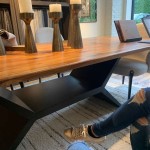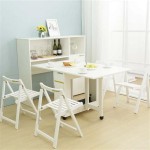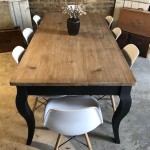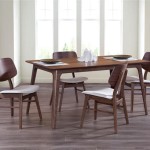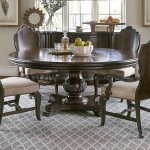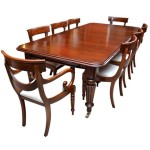Glass Dining Room Table Sets: Elegance, Functionality, and Considerations
Glass dining room table sets have become increasingly popular, offering a sleek and modern aesthetic that can transform any dining space. Their transparent surface provides a sense of spaciousness, making them particularly well-suited for smaller rooms. Beyond their visual appeal, these sets offer a range of practical benefits and considerations that are worth exploring before making a purchase.
The appeal of glass dining room tables lies in their versatility. They can seamlessly integrate into a variety of interior design styles, from minimalist and contemporary to industrial and even transitional. The transparency of the glass allows the surrounding décor and flooring to remain visible, preventing the table from visually dominating the room. This characteristic makes glass tables an excellent choice for those who want to showcase their existing design elements.
However, choosing the right glass dining room table set requires careful consideration of several factors, including glass type, frame material, size, and maintenance requirements. Understanding these aspects will ensure that the selected set meets both aesthetic preferences and practical needs.
Key Point 1: Types of Glass and Frame Materials
The construction of a glass dining room table set involves two primary components: the glass tabletop and the supporting frame. The quality and characteristics of these materials significantly impact the table's durability, safety, and overall appearance.
Tempered glass is the most commonly used type for dining room tables due to its strength and safety features. It is treated with heat to increase its resistance to breakage. If tempered glass does break, it shatters into small, relatively harmless pieces, reducing the risk of serious injury compared to standard glass. The thickness of the glass is another crucial factor, with thicker glass generally being more durable and resistant to scratches and impacts. A thickness of at least 10mm is typically recommended for dining room tables.
Laminated glass offers an even higher level of safety. It consists of two or more layers of glass bonded together with a layer of interlayer material, typically polyvinyl butyral (PVB). If laminated glass breaks, the interlayer holds the fragments in place, preventing them from scattering and minimizing the risk of injury. This type of glass is often used in high-traffic areas or where safety is a primary concern.
The frame material provides structural support and contributes to the table's overall style. Common frame materials include metal, wood, and acrylic. Metal frames, particularly those made of stainless steel or chrome, offer a modern and industrial look. They are known for their durability and resistance to corrosion. Wood frames provide a warmer and more traditional aesthetic. The type of wood used, such as oak, maple, or walnut, will influence the table's color and grain pattern. Acrylic frames are a contemporary option, offering a transparent or translucent appearance that complements the glass tabletop. They are lightweight and relatively easy to clean.
The choice of frame material should be based on the desired aesthetic, the level of durability required, and the overall budget. Metal frames tend to be more expensive than wood or acrylic frames, but they offer superior longevity. Wood frames can be a cost-effective option, but they may require more maintenance to prevent moisture damage and warping.
Key Point 2: Size and Shape Considerations
Selecting the appropriate size and shape of a glass dining room table is essential for ensuring comfortable seating and maximizing the functionality of the dining space. The table should be large enough to accommodate the typical number of diners while allowing sufficient room for movement around the table.
The size of the dining room is a primary factor to consider. In smaller rooms, a round or oval table can be a good choice, as it allows for easier navigation and prevents sharp corners from obstructing traffic flow. Rectangular tables are best suited for larger rooms, as they provide ample seating and a more formal dining experience. Square tables are a versatile option that can work well in both small and medium-sized rooms.
When determining the appropriate table size, it is important to consider the number of people who will typically be using the table. A general guideline is to allow at least 24 inches of width per person and 12 inches of depth for place settings. For example, a rectangular table that measures 60 inches in length and 36 inches in width can comfortably accommodate six people. A round table with a diameter of 48 inches can also seat six people.
The shape of the table can also impact the overall ambiance of the dining room. Round tables promote conversation and create a more intimate dining experience. Rectangular tables are often preferred for formal dinners and can accommodate larger groups. Square tables offer a balance between formality and intimacy and can be easily pushed against a wall to save space when not in use.
In addition to the table's dimensions, it is important to consider the height of the table and chairs. The standard dining table height is 30 inches, and the standard chair seat height is 18 inches. This allows for comfortable legroom and ensures that diners can easily reach their plates. When selecting chairs, it is important to consider the style and material. Chairs with upholstered seats and backs provide greater comfort, while chairs with wooden or metal frames offer a more streamlined look. The chairs should complement the style of the table and the overall design of the dining room.
Key Point 3: Maintenance and Care
Maintaining a glass dining room table set requires regular cleaning and care to preserve its appearance and prevent scratches or damage. While glass is generally a durable material, it is susceptible to fingerprints, smudges, and scratches. Proper cleaning techniques and protective measures can help to keep the table looking its best.
Regular cleaning is essential for removing fingerprints, smudges, and food residue. A simple solution of warm water and mild dish soap is usually sufficient for everyday cleaning. Use a soft, lint-free cloth or microfiber cloth to wipe the surface of the glass. Avoid using abrasive cleaners or scouring pads, as these can scratch the glass. For stubborn stains, a glass cleaner or vinegar solution can be used. Always wipe the glass dry after cleaning to prevent water spots.
To prevent scratches, avoid placing sharp or abrasive objects directly on the glass surface. Use placemats and coasters to protect the glass from hot dishes, spills, and scratches. When moving objects across the table, lift them rather than sliding them. Consider using a glass protector or tablecloth for special occasions or when using the table for activities that may scratch the surface.
The frame material also requires regular maintenance. Metal frames can be cleaned with a damp cloth and mild soap. Avoid using harsh chemicals or abrasive cleaners, as these can damage the finish. Wood frames should be dusted regularly and protected from moisture. Use furniture polish or wax to maintain the wood's luster and prevent drying or cracking. Acrylic frames can be cleaned with a soft cloth and mild soap. Avoid using alcohol-based cleaners, as these can damage the acrylic.
In addition to regular cleaning and maintenance, it is important to inspect the table periodically for any signs of damage, such as chips, cracks, or loose screws. Addressing these issues promptly can prevent further damage and extend the lifespan of the table. If the glass is chipped or cracked, it should be repaired or replaced by a professional to prevent injury.
Proper maintenance and care will ensure that a glass dining room table set remains a beautiful and functional addition to the home for many years. By following these guidelines, it is possible to preserve the table's appearance and prevent damage, ensuring that it continues to enhance the dining experience.
Beyond the practical aspects, the choice of chairs to accompany the glass table is crucial for aesthetics. Consider chairs with metal frames to complement a modern glass table, or upholstered chairs for a more comfortable and luxurious feel. The color and style of the chairs should harmonize with the overall décor of the room.
Lighting also plays a role in showcasing the beauty of a glass dining room table. A chandelier or pendant light hanging above the table can create a focal point and enhance the transparency of the glass. Natural light can also highlight the table's sleek lines and minimalist design. Strategically placed lamps can add warmth and ambiance to the dining space.
Ultimately, selecting a glass dining room table set involves balancing aesthetic preferences with practical considerations. By carefully evaluating the glass type, frame material, size, shape, and maintenance requirements, it is possible to choose a set that meets both visual and functional needs, creating a stylish and inviting dining space.

Magic Home 70 86 In Large Modern Rectangular Tempered Glass Dining Table Top With Mdf Base Black Seats 8 Mh Dtt16w Dtl2g The

Furniture Amy 5 Pc Dining Set Round Glass Table 4 Side Chairs In Grey Macy S

Furniture Of America Jacreme Glass Top Round Dining Table Silver Wal Com

Glass Top Dining Table With 8 Chairs In Tucson Homestyle Galleries Furniture

Oliver Edwin 5 Piece Round Clear Glass Dining Table Set With 4 Tan Faux Leather Chairs Walnut Legs The Pop Maison

Hana Flavia 5 Piece Round Clear Glass Gold Legs Dining Table Set With 4 Upholstered Chairs The Pop Maison

Nabu Extendable Glass Dining Table Offers Additional Seating

Jensen Round Dining Table 42 West Elm

71 Contemporary Rectangle Tempered Glass Top Dining Table Homary

Forclover 71 In Rectangular Luxury Modern White Stone Dining Table With Solid Black Carbon Steel Base For Room Seats 8 Monmucf 07dt01 The Home

